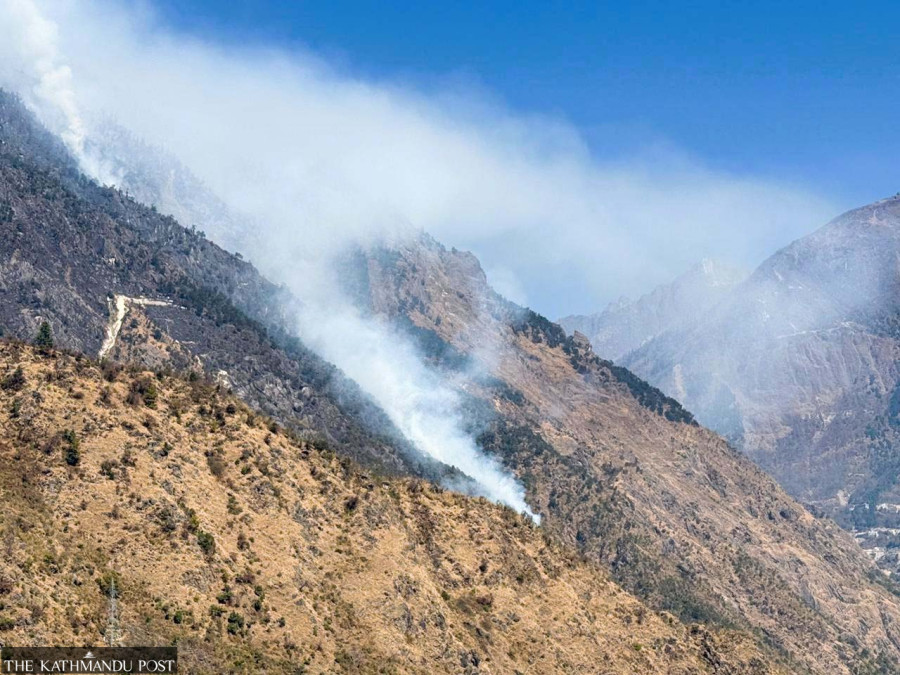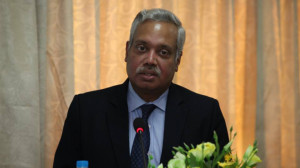National
Efforts fail to douse fires raging in three mountain districts
Blazes are spreading unchecked in Dolakha, Sindhupalchok and Manang forests. Wildlife and settlements under threat.
Kedar Shiwakoti, Anish Tiwari & Aash Gurung
A wildfire that started raging in the higher reaches of Gaurishankar Rural Municipality under Gaurishankar Conservation Area in Dolakha district on Friday has gone out of control. The inferno, which spread above Sikpaswar area, has engulfed vast swaths of forest and grassland, and threatened wildlife and people living in the surrounding area.
Locals have been terrorised with the fire spreading in the dense forest of Himalayan bamboo, known as Nigalo in Nepali, in a high altitude area above 3,000 metres. “The fire is spreading rapidly in the forests and grasslands. We tried to control it but we could not reach the area. The wildfire has spread since yesterday (Monday) and is now out of control,” said Kumar Gurung, chairman of Gaurishankar Conservation Management Local Committee in Marbu.
Thick smoke from the wildfire has blanketed Mt Gaurishankar, the Rolwaling mountain range, and high-altitude settlements in northern Dolakha. “The fire completely destroyed dense forests of Himalayan bamboo, the major habitat of the endangered red panda, and it is spreading into lower reaches. The wildfire in Khasru forest is out of control,” said Gurung.
Wildfires are not uncommon in this region, but this year the blaze began unusually early, in January, a time when these forests are typically blanketed by snow.
Conservationists are worried as the wildfire continues to destroy wildlife habitats. Wild animals, which descend to lower altitudes during the cold winter months, have been severely affected. According to Tulsi Prasad Dahal, chief of the conservation area, the fire has intensified over the past few days, especially around the pastures near the mountains. These areas are home to species such as the red panda and the Himalayan tahr.
“We are still investigating the cause of the fire. If it continues at this pace, it will destroy a huge portion of the conservation area,” said Dahal. “Two teams were mobililsed to control the blaze, but due to the difficult terrains, they were unable to extinguish it and had to retreat. We have requested the district disaster management committee for more support.” Strong winds in the Himalayan region are accelerating the spread, according to Dahal.

The Gaurishankar area is typically covered in snow from mid-December, and fires are rare in the upper reaches during the snowy season. However, Dahal revealed that wildfires have become increasingly frequent in recent years, with two incidents already reported this year. Due to the lack of snowfall, fires have begun earlier than usual, particularly in higher altitude areas.
Meanwhile, the wildfire in the forested areas of Liping in ward 2 of Bhotekoshi Rural Municipality in Sindhupalchok district also remains uncontrolled. The fire, which started Friday, is gradually spreading towards Dolakha. Residents of ward 6 and 7 of Bigu Rural Municipality in Dolakha have been affected due to the thick smoke coming from the Liping area.
“The wildfire in the Sindhupalchok area is spreading towards Dolakha. Thick smoke has blanketed the villages in Bigu. It has been difficult to run classes due to the smoke,” said Tulasi Thami, principal of Thampu Secondary School in ward 7 of Bigu. Bigu Rural Municipality borders Sindhupalchok district.
“Efforts are on to prevent the wildfire in Sindhupalchok from entering Dolakha by creating fire lines. Security agencies and conservation officials are working to douse the flames, with little success,” said Dahal.
In Sindhupalchok, the wildfire that erupted in the Liping forest area on Friday has put Rangbusa village at immediate risk. Rangbusa, home to 20 Thami and Tamang families, is now in danger as the fire inches closer. Residents have sought urgent assistance.
“We have been unable to sleep, fearing the fire. Thick smoke has engulfed the forest, and flames are just a few metres away from our homes,” said Rita Thami, a local resident.
The fire started on Friday at the tunnel site of the under-construction Liping
Khola Hydropower Project due to an electrical short circuit, according to Kumar Shrestha, ward 2 chair of Bhotekoshi Rural Municipality.
On Sunday, the rural municipality arranged for a helicopter to fetch water from the Bhotekoshi River, with the hydropower project covering the cost. However, the fire near the village remains out of control.
“Although the fire has subsided to an extent, strong winds continue to fan the flames,” said local resident Sarju Lama. The helicopter made 54 trips on Sunday alone, each carrying 800 litres of water, but efforts to contain the blaze failed. Security personnel and locals have struggled with high winds.
The fire has spread to forests and cliffs within the Gaurishankar Conservation Area, making it harder to extinguish, said Chief District Officer Kiran Thapa.
“With human efforts proving insufficient, a Simrik Air helicopter has also been used to douse flames. The priority is to protect Rangbusa village by drawing water from Bhotekoshi,” Thapa said.
Security personnel from the Nepal Army, Armed Police Force, and Nepal Police have been deployed.
Similarly in Manang district, the wildfire that broke out above Timang village in ward 1 of Chame Rural Municipality on Friday remains out of control. According to Chief District Officer of Manang Matrika Acharya, difficult terrain has made the firefighting efforts nearly impossible. The fire has already spread to altitudes of 3,000 metres, he added.
A meeting was held on Tuesday to discuss fire control efforts. According to Deputy Superintendent of Police Naresh Kumar Singh, the meeting agreed to mobilise security personnel, employees of Annapurna Conservation Area Project and local residents to create fire lines and protect human settlements.
The ongoing wildfires in Dolakha, Sindhupalchok, and Manang highlight the increasing risks of wildfires in high-altitude regions, especially during unusual climatic patterns. Conservation efforts in these areas are becoming increasingly critical to safeguard both the environment and the wildlife that inhabit these fragile ecosystems.




 16.12°C Kathmandu
16.12°C Kathmandu

.jpg)















